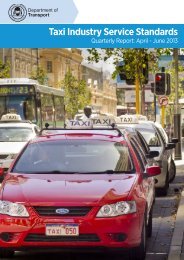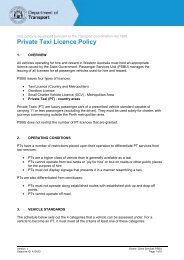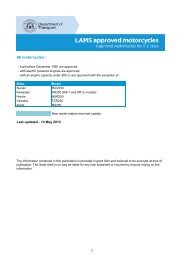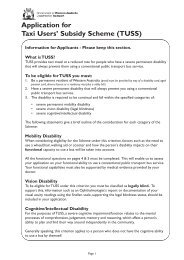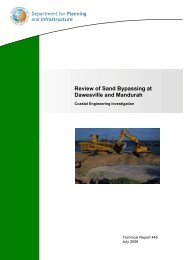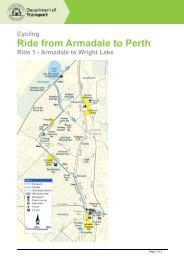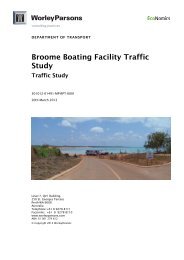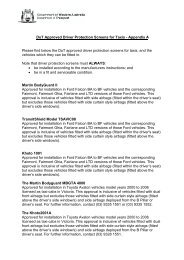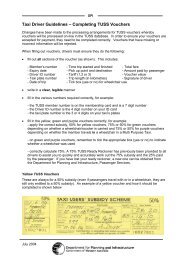Department of Transport Annual Report 2010 - 2011
Department of Transport Annual Report 2010 - 2011
Department of Transport Annual Report 2010 - 2011
You also want an ePaper? Increase the reach of your titles
YUMPU automatically turns print PDFs into web optimized ePapers that Google loves.
Percentage by which the waiting time standard for metropolitan area taxis is met<br />
DoT is responsible for regulation <strong>of</strong> the Perth metropolitan taxi industry via the<br />
administration <strong>of</strong> the Taxi Act 1994.<br />
Following the 1999 National Competition Policy Review <strong>of</strong> the Perth metropolitan taxi<br />
industry, the then DPI introduced industry performance standards. The standards<br />
have been in place since 1 July 2000 and the taxi industry is required to meet these<br />
performance standards.<br />
An independent external consultant analyses taxi industry data, sourced from the<br />
TDS providers, and reports on taxi demand and industry viability trends as well as<br />
the performance <strong>of</strong> the taxi industry against the industry standards on a monthly and<br />
quarterly basis.<br />
This assessment gives DoT the ability to provide the Minister with evidence-based policy<br />
recommendations and therefore directly assists the regulatory function <strong>of</strong> the DoT.<br />
In addition to JNC, taxi performance is measured by determining the average time<br />
a customer has to wait for a taxi following a booking, during peak and <strong>of</strong>f-peak<br />
times, and then comparing the result against the relevant performance standards. To<br />
calculate this measure, the wait times for taxis requested as soon as possible (asap)<br />
have been measured during peak and <strong>of</strong>f-peak times, and bookings that meet the<br />
performance standard are presented as a percentage against all asap bookings.<br />
Trends from this indicator assist with determining supply and demand requirements<br />
for the industry and provide rationale for determining whether or not there is a<br />
requirement to release additional taxi plates.<br />
Industry performance is assessed by obtaining and analysing data from the two<br />
major TDS providers in the metropolitan area. Waiting time information is available<br />
from the TDS systems and measured as the difference between when the customer<br />
first requested the taxi and when the driver turned on their meter to start the job.<br />
Percentage by<br />
which the waiting<br />
time standard<br />
for metropolitan<br />
area taxis is met.<br />
96<br />
2007-08<br />
actual<br />
2008-09<br />
actual<br />
2009-10<br />
actual<br />
<strong>2010</strong>-11<br />
target<br />
<strong>2010</strong>-11<br />
actual<br />
87.2% 91.1% 91.8% 90.0% 91.9%<br />
Reasons for<br />
significant<br />
variance<br />
Percentage <strong>of</strong> time maritime infrastructure is fit for purpose when required<br />
DoT is responsible for the planning, creation, enhancement and management <strong>of</strong><br />
new and existing land and water based maritime facilities for small craft throughout<br />
Western Australia.<br />
DoT manages and maintains a variety <strong>of</strong> maritime infrastructure assets, including<br />
jetties, wharves, boat launching facilities, pens and moorings at approximately<br />
50 discrete locations throughout the State, to service the fishing and commercial<br />
maritime industries and the recreational boating needs <strong>of</strong> Western Australians.<br />
DoT also maintains associated navigational aids that are strategically placed in<br />
water and onshore to ensure that the boating community can safely transit through<br />
waterways. It also maintains the navigable waters at its managed maritime facilities<br />
as well as at a small number <strong>of</strong> other locations, including two commercial ports,<br />
throughout the State by providing access via dredged channels.<br />
The facilities and their purpose vary for each location and the associated management<br />
and maintenance plans vary accordingly.<br />
The outcome <strong>of</strong> this indicator is measured by determining the percentage <strong>of</strong> time<br />
each <strong>of</strong> the four infrastructure categories (1. Pens and moorings, 2. Jetties and other<br />
infrastructure, 3. Navigational aids, and 4. Dredged channels) is fit for purpose when<br />
required, then calculating the average percentage across all four to arrive at the<br />
measure.<br />
A consistently high percentage <strong>of</strong> availability will confirm that maritime infrastructure<br />
is being appropriately maintained and is accessible to the boating industries and the<br />
public <strong>of</strong> Western Australia.<br />
Percentage <strong>of</strong><br />
time maritime<br />
infrastructure is<br />
fit for purpose<br />
when required.<br />
2007-08<br />
actual<br />
2008-09<br />
actual<br />
2009-10<br />
actual<br />
<strong>2010</strong>-11<br />
target<br />
<strong>2010</strong>-11<br />
actual<br />
98.77% 99.65% 99.87% 99.65% 99.73%<br />
Reasons for<br />
significant<br />
variance



